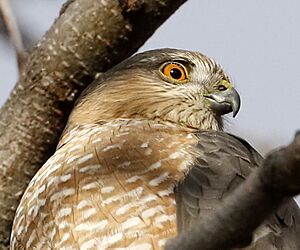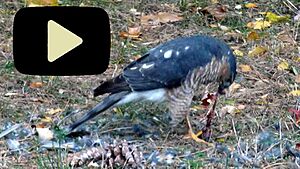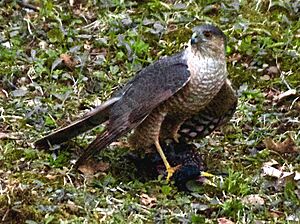Sharp-shinned hawk facts for kids
Quick facts for kids Sharp-shinned hawk |
|
|---|---|
 |
|
| Conservation status | |
| Scientific classification | |
| Genus: |
Accipiter
|
| Species: |
striatus
|
| Subspecies | |
|
A. s. chionogaster |
|
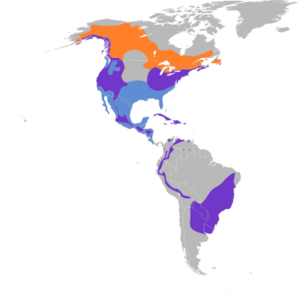 |
|
| Breeding Year-round Nonbreeding | |
| Synonyms | |
|
Accipiter velox |
|
The sharp-shinned hawk (Accipiter striatus), also called the northern sharp-shinned hawk or just a sharpie, is a small hawk. Male sharp-shinned hawks are the smallest hawks in the United States and Canada. However, the species as a whole is bigger than some hawks found in warmer, southern areas, like the tiny hawk.
Scientists are still figuring out how to classify these birds. Some experts think that the sharp-shinned hawks from southern regions are actually three separate species. These are the white-breasted hawk (A. chionogaster), the plain-breasted hawk (A. ventralis), and the rufous-thighed hawk (A. erythronemius). Other groups, like the American Ornithological Society, consider all these variations to be part of the same species.
Contents
Hawk Family Tree: Taxonomy
The sharp-shinned hawk is sometimes divided into four different species. The northern group, which includes the hawks found in the USA and Canada, keeps the original scientific name A. striatus and the common name "sharp-shinned hawk." This group has several types, called subspecies.
The other three groups are sometimes considered their own species:
- The white-breasted hawk (A. chionogaster)
- The plain-breasted hawk (A. ventralis)
- The rufous-thighed hawk (A. erythronemius)
These different groups live in separate areas, though their winter homes might sometimes overlap. They also look a bit different. However, many experts still consider them all one widespread species. This is because there isn't enough strong scientific proof yet to officially split them into separate species.
A study in 2021 suggested that three types of sharp-shinned hawks living on Caribbean islands should be recognized as distinct species. These are A. striatus from Hispaniola, A. fringilloides from Cuba, and A. venator from Puerto Rico. If this idea is accepted, the hawks on the main continents would then be called A. velox.
What Sharp-shinned Hawks Look Like
Sharp-shinned hawks are small Accipiter hawks. Males are about 23 to 30 cm (9.1 to 11.8 in) long, with a wingspan of 42 to 58 cm (17 to 23 in). They weigh between 82–115 g (2.9–4.1 oz).
Like many Accipiter hawks, females are much larger. They are about 30% longer and can weigh more than 50% more than males. Females are 29 to 37 cm (11 to 15 in) long, with a wingspan of 58 to 68 cm (23 to 27 in). They weigh 150 to 219 g (5.3 to 7.7 oz).
These hawks have short, wide wings and a medium-length tail. The tail has black and gray bands, and its tip can be slightly notched, square, or slightly rounded. Their legs are long, thin, and yellow. Their hooked beak is black, and the skin around it (called the cere) is yellowish.
The rest of their feathers vary depending on the group:
- Northern Group: Adults have a dark cap and blue-gray upper parts. Their undersides are white with reddish or brownish bars. Their thighs are reddish, often with white bars. Their eyes are dark orange to red, but young hawks have yellowish or pale orange eyes. Young hawks have brownish upper parts with reddish edges on each feather, making them look a bit scaly. Their heads are streaked with white, and their white undersides have many brown or reddish streaks.
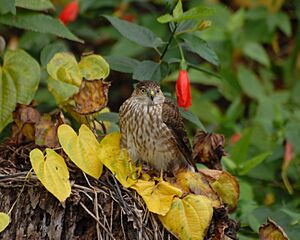
- White-breasted Hawk (A. (s.) chionogaster): These look similar to the northern group, but their upper parts are darker, sometimes almost black. Their thighs are whitish, and their undersides and cheeks are completely white. Young white-breasted hawks have darker upper parts and thinner streaks on their undersides than young northern hawks.
- Plain-breasted Hawk (A. (s.) ventralis): These hawks can look quite different from each other. The most common type has dark gray upper parts (often looking almost black) and white undersides. The white undersides have varying amounts of reddish or brownish bars, shades, or spots. Some individuals may look almost entirely reddish or brownish underneath. There is also a rare dark type that is mostly sooty-colored. Their eyes are usually yellow. Young plain-breasted hawks have dark brownish upper parts with reddish edges on their feathers. Their undersides are white with brown streaks, and their thighs are reddish with white bars.
- Rufous-thighed Hawk (A. (s.) erythronemius): These hawks resemble the northern group, but their upper parts are darker. The streaks on their undersides are reddish or dusky. They usually have a clear reddish patch on their cheeks, and their eyes are yellow. Young rufous-thighed hawks look like young northern hawks, but the streaks on their undersides are usually only on their throat and central body, with the sides looking scaly or barred.
Where Sharp-shinned Hawks Live: Distribution
This hawk species lives in many places, including North America, Central America, South America, and the Greater Antilles. Here's where the different groups are found, generally from north to south:
- Northern Group (A. s. striatus): These hawks are common in North America. They live in most forested areas of the USA and Canada. Hawks from the northern parts of their range migrate south for winter. They spend the colder months in the southern USA, Mexico, and Central America, going as far south as Panama. Some also winter in the Greater Antilles. Some populations in warmer parts of the US, Canada, Mexico, Cuba, Hispaniola, and Puerto Rico stay in the same place all year.
- White-breasted Hawk (A. (s.) chionogaster): This hawk lives in the highlands of southern Mexico (like Chiapas and Oaxaca), and through Honduras, Guatemala, El Salvador, to Nicaragua. They usually stay in the same area all year.
- Plain-breasted Hawk (A. (s.) ventralis): These hawks are found in the coastal mountains of northern Venezuela and Colombia. They also live in the Andes mountains, from western Venezuela, through Colombia, Ecuador, and Peru, down to central Bolivia. They are also found in a separate area in the Tepuis of southern Venezuela. They generally do not migrate.
- Rufous-thighed Hawk (A. (s.) erythronemius): This hawk is common in eastern South America. It lives in eastern and southern Brazil, Uruguay, Paraguay, north-eastern Argentina, and south-eastern Bolivia. Some populations stay in one place, while others migrate. Their movements are not fully understood.
Sharp-shinned Hawk Homes: Habitat
Sharp-shinned hawks live in many types of woodlands and forests. These can be forests with conifer trees (like pines) or forests with different kinds of broad-leaved trees (like oaks).
The largest groups of northern sharp-shinned hawks are thought to live in cool temperate forests, but they fly to warmer places farther south for winter. The other types of sharp-shinned hawks, like the white-breasted hawk and plain-breasted hawk, are found in high tropical to temperate areas. They usually live at altitudes of 300–3,000 m (980–9,840 ft), but sometimes as low as sea-level or as high as 4,000 m (13,000 ft). The rufous-thighed hawk lives in tropical and subtropical regions, both in lowlands and highlands.
Sharp-shinned Hawk Behavior
What Sharp-shinned Hawks Eat: Diet
These hawks are very good at surprising their prey. They often catch animals from a hidden spot or by flying quickly through thick trees and bushes. They are skilled at moving through dense areas, even though this way of hunting can be risky for them.
Most of what sharp-shinned hawks eat are small birds. These include many types of songbirds like sparrows, wood-warblers, finches, wrens, and thrushes. They can catch birds ranging from a tiny 4.4 g (0.16 oz) Anna's hummingbird to a 577 g (1.272 lb) ruffed grouse. Almost any bird within this size range can be their meal.
Male hawks usually hunt smaller birds, while females go after larger prey like American robins. This helps prevent the males and females from competing for the same food. These hawks often visit backyard bird feeders because many small birds gather there, making them easy targets. They often pluck the feathers off their prey on a post or branch.
Sometimes, sharp-shinned hawks will also eat small animals like rodents, lizards, frogs, snakes, and large insects. They might catch dragonflies while flying during their migration. Very rarely, they have even been seen eating Bats.
Sharp-shinned Hawk Life Cycle: Reproduction
Sharp-shinned hawks build their nests out of sticks. They usually place them in large conifer trees or in thick groups of deciduous trees. A female hawk typically lays 4 to 5 eggs, though sometimes it can be as few as 3 or as many as 8. Each egg is about 37.6 mm × 30 mm (1.48 in × 1.18 in) and weighs around 19 g (0.67 oz).
The eggs are very colorful and have unique markings. The eggs hatch after about 30 days. Once the young hawks hatch, the female stays with them for 16 to 23 days to keep them warm and safe. During this time, the male hawk protects their territory and hunts for food. The young hawks learn to fly when they are about a month old. They still depend on their parents for food and protection for another four weeks after they fledge.
Sharp-shinned hawks keep their nesting sites and breeding habits very secret. This helps them avoid larger birds of prey, like the American goshawk and the Cooper's hawk, from attacking their young. Adult sharp-shinned hawks can sometimes be hunted by larger birds, especially the peregrine falcon, when they are migrating. The breeding habits of the other sharp-shinned hawk groups are not as well known, but they seem to be similar to the northern group.
Protecting Sharp-shinned Hawks: Conservation
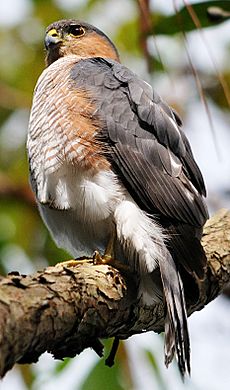
In North America, the number of sharp-shinned hawks went down in the 1960s and 1970s. This was probably because of harmful chemicals like DDT and other pesticides. However, their population in the USA and Canada has grown back since then. It might even be higher than it was before. This is likely due to the ban on DDT and the increase of backyard bird feeders. Bird feeders create easy and reliable food sources for the hawks.
Sharp-shinned hawks are one of the most common birds of prey seen at "hawk watches" across the country during migration. However, one type of sharp-shinned hawk from Puerto Rico, called Accipiter striatus venator, is rare. It is listed as endangered by the U.S. Fish & Wildlife Service. The other types of sharp-shinned hawks that live in the Greater Antilles, fringilliodes from Cuba and A. s. striatus from Hispaniola, are not common and their numbers are decreasing.
The plain-breasted hawk (ventralis) and the rufous-thighed hawk (erythronemius) are fairly common. They are hard to spot because they are secretive, but their populations are currently considered safe. The white-breasted hawk (chionogaster) might be in more trouble because it lives in a smaller area, but it is still fairly common in some places.




